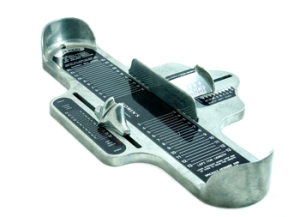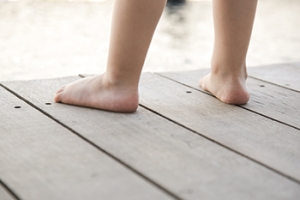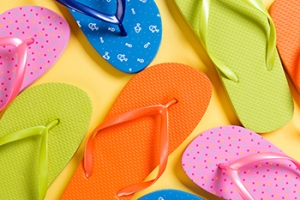Connect With Us

Healing From Hammertoe Surgery

Recovering from hammertoe surgery requires attentive care to ensure proper healing and prevent complications. Follow your doctor's instructions regarding pain relief and any prescribed antibiotics to avoid infection. Keeping the pain under control will also help you stay mobile and adhere to post-surgery exercises. A balanced diet rich in vitamins and minerals supports the healing process, with particular emphasis on nutrients like vitamin C and protein to aid tissue repair. Incision care is vital for preventing infections includes keeping the surgical site clean and dry and following your podiatrist's guidelines on changing dressings. Avoid soaking the foot until the incision is fully healed, and watch for signs of infection like increased redness, swelling, or discharge. Elevating the foot and limiting activity as recommended will reduce swelling and promote faster recovery. If you have had hammertoe surgery, it is suggested that you keep in close contact with your podiatrist who can monitor your recovery.
Foot surgery is sometimes necessary to treat a foot ailment. To learn more, contact Michael Tomey, DPM of Cary Foot & Ankle Specialists. Our doctor will assist you with all of your foot and ankle needs.
When Is Surgery Necessary?
Foot and ankle surgery is generally reserved for cases in which less invasive, conservative procedures have failed to alleviate the problem. Some of the cases in which surgery may be necessary include:
- Removing foot deformities like bunions and bone spurs
- Severe arthritis that has caused bone issues
- Cosmetic reconstruction
What Types of Surgery Are There?
The type of surgery you receive will depend on the nature of the problem you have. Some of the possible surgeries include:
- Bunionectomy for painful bunions
- Surgical fusion for realignment of bones
- Neuropathy decompression surgery to treat nerve damage
Benefits of Surgery
Although surgery is usually a last resort, it can provide more complete pain relief compared to non-surgical methods and may allow you to finally resume full activity.
Surgical techniques have also become increasingly sophisticated. Techniques like endoscopic surgery allow for smaller incisions and faster recovery times.
If you have any questions please feel free to contact our office located in Cary, NC . We offer the newest diagnostic and treatment technologies for all your foot and ankle needs.
Foot Surgery
In most cases, foot surgery is often chosen as the last available option for conditions that have otherwise been unsuccessfully treated. Surgery may be necessary for several reasons, including the removal of foot deformities (e.g. bone spurs or bunions), arthritis problems, reconstruction due to injury, and congenital malformations (e.g. club foot or flat feet). Regardless of one’s age, foot surgery may be the only successful option for treatment for certain conditions.
The type of surgery one undergoes depends on the type of foot condition the patient has. For the removal of a bunion growth, a bunionectomy is necessary. If the bones in the feet need to be realigned or fused together, a surgical fusion of the foot is needed. For pain or nerve issues, a patient may require surgery in which the tissues surrounding the painful nerve are removed. Initially, less invasive treatments are generally attempted; surgery is often the last measure taken if other treatments are unsuccessful.
While in many cases surgery is often deemed as the final resort, choosing surgery comes with certain benefits. The associated pain experienced in relation to the particular condition is often relieved with surgery, allowing patients to quickly resume daily activities. The greatest benefit, however, is that surgery generally eliminates the problem immediately.
Podiatry history has shown that foot treatments continue to evolve over time. In the field of foot surgery, endoscopic surgery is just one of the many advanced forms of surgery. As technology vastly improves so too will the various techniques in foot surgery, which already require smaller and smaller incisions with the use of better and more efficient tools. Thanks to such innovations, surgery is no longer as invasive as it was in the past, allowing for faster and easier recoveries.
How Gout Affects Feet
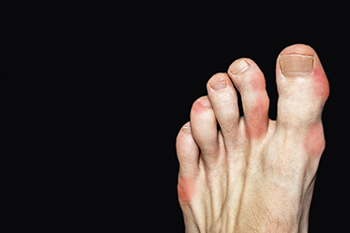 Gout is a type of arthritis that causes sudden, severe attacks of pain, redness, and tenderness in joints, often affecting the feet. It occurs when urate crystals accumulate in the joints, causing inflammation and intense pain. These crystals form when there are high levels of uric acid in the blood. The body produces uric acid when it breaks down purines, substances found naturally in the body, and certain foods. Gout can affect anyone, but it is more common in men, postmenopausal women, and individuals with kidney disease or a family history of gout. In the feet, gout typically impacts the big toe, but it can also affect other parts like the ankles and heels. The pain can be excruciating, described as a burning or stabbing sensation, often waking individuals from sleep. Swelling, redness, and warmth in the affected area are common symptoms. To manage gout, lifestyle changes such as diet modification, weight loss, and avoiding alcohol are recommended. Medications to reduce uric acid levels and inflammation may also be prescribed. If you experience severe foot pain due to gout, it is suggested that you schedule an appointment with a podiatrist for targeted treatment and management strategies.
Gout is a type of arthritis that causes sudden, severe attacks of pain, redness, and tenderness in joints, often affecting the feet. It occurs when urate crystals accumulate in the joints, causing inflammation and intense pain. These crystals form when there are high levels of uric acid in the blood. The body produces uric acid when it breaks down purines, substances found naturally in the body, and certain foods. Gout can affect anyone, but it is more common in men, postmenopausal women, and individuals with kidney disease or a family history of gout. In the feet, gout typically impacts the big toe, but it can also affect other parts like the ankles and heels. The pain can be excruciating, described as a burning or stabbing sensation, often waking individuals from sleep. Swelling, redness, and warmth in the affected area are common symptoms. To manage gout, lifestyle changes such as diet modification, weight loss, and avoiding alcohol are recommended. Medications to reduce uric acid levels and inflammation may also be prescribed. If you experience severe foot pain due to gout, it is suggested that you schedule an appointment with a podiatrist for targeted treatment and management strategies.
Gout is a foot condition that requires certain treatment and care. If you are seeking treatment, contact Michael Tomey, DPM from Cary Foot & Ankle Specialists. Our doctor will treat your foot and ankle needs.
What Is Gout?
Gout is a type of arthritis caused by a buildup of uric acid in the bloodstream. It often develops in the foot, especially the big toe area, although it can manifest in other parts of the body as well. Gout can make walking and standing very painful and is especially common in diabetics and the obese.
People typically get gout because of a poor diet. Genetic predisposition is also a factor. The children of parents who have had gout frequently have a chance of developing it themselves.
Gout can easily be identified by redness and inflammation of the big toe and the surrounding areas of the foot. Other symptoms include extreme fatigue, joint pain, and running high fevers. Sometimes corticosteroid drugs can be prescribed to treat gout, but the best way to combat this disease is to get more exercise and eat a better diet.
If you have any questions please feel free to contact our office located in Cary, NC . We offer the newest diagnostic and treatment technologies for all your foot and ankle needs.
Everything You Need to Know About Gout
Gout, typically found in diabetic patients, is an unusually painful form of arthritis caused by elevated levels of uric acid in the bloodstream. The condition typically strikes the big joint on the big toe. It has also been known to strike the knees, elbows, fingers, ankles and wrists—generally anywhere that has a functioning, moving joint.
The high level of uric acid in a person’s bloodstream creates the condition known as hyperuricema—the main cause of gout. Genetic predisposition occurs in nine out of ten sufferers. The children of parents who suffer gout will have a two in ten chance of developing the condition as well.
This form of arthritis, being particularly painful, is the leftover uric acid crystallizing in the blood stream. The crystallized uric acid then travels to the space between joints where they rub, causing friction when the patient moves. Symptoms include: pain, redness, swelling, and inflammation. Additional side effects may include fatigue and fever, although reports of these effects are very rare. Some patients have reported that pain may intensify when the temperature drops, such as when you sleep.
Most cases of gout are easily diagnosed by a podiatrist’s assessment of the various symptoms. Defined tests can also be performed. A blood test to detect elevated levels of uric acid is often used as well as an x-ray to diagnose visible and chronic gout.
Treatment for gout simply means eliminating symptoms. Non-steroid anti-inflammatory drugs or NSAIDs (Colchicine and other corticosteroid drugs, etc.) will quell the redness, the swelling, and the inflammation. However, managing your diet, lifestyle changes, and using preventative drugs are all helpful toward fully combating the most severe cases.
Those that lead an inactive lifestyle are at a higher risk for gout. Any amount of exercise decreases the probability of repeat encounters with the condition. Reducing your consumption of red meat, sea food, and fructose-sweetened drinks also reduces the likelihood of chronic gout as well.
Ingesting Vitamin C, coffee, and particular dairy products can help with maintaining a healthy lifestyle. There are new drugs out on the market that inhibit the body’s production of uric acid-producing enzymes. However, reducing or eliminating your overall levels of uric acid is the best remedy to ensuring you lead a gout-free life.
Shoe Fitting Tests for Older Adults Using a Brannock Device and 3D Foot Scanning
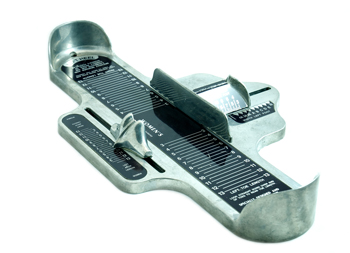
Ensuring accurate shoe fitting in older adults is essential for comfort and mobility. The Brannock device, a traditional tool used for decades, measures foot length and width manually. While it is reliable for basic measurements, it does not capture the full complexity of foot shape. In contrast, three-dimensional, or 3D, foot scanning technology offers a more comprehensive analysis. This advanced method creates a detailed digital model of the foot, accounting for variations in arch height, toe shape, and other nuances. Older adults, who often experience changes in foot structure due to aging, can benefit significantly from the precision of 3-D scanning. This technology provides tailored recommendations, enhancing both comfort and support. Although the Brannock device remains a valuable tool, the detailed insights from 3-D foot scanning represent a significant advancement in ensuring the best fit for older individuals. If you are wearing shoes that do not fit properly and have developed a foot condition, it is suggested that you visit a podiatrist who can help you with relief options and guide you on the best way to determine your shoe size.
Finding a properly-fitting shoe is important in reducing injuries and preventing foot problems. For more information about treatment, contact Michael Tomey, DPM from Cary Foot & Ankle Specialists. Our doctor will treat your foot and ankle needs.
Proper Shoe Fitting
A common concern when it comes to foot health, having properly fitted shoes can help prevent injuries to the foot. Out feet affect our posture and gait, which in turn affects the biomechanics and overall bodily structure. With 33 joints, 26 bones, and over 100 ligaments, the potential for serious injury is much greater than one realizes. Although the feet cease growth in adulthood, they still change shape as they mature. Here are some factors to consider when it comes to investing in proper fitting shoes:
- Be sure the shoes fit correctly right away
- Ensure the ball of your foot fits comfortably in the widest portion of the shoes
- Even though they may look fashionable, improper fitting shoes can either create adverse conditions or exacerbate existing ones you may already have
- Walk along a carpeted surface to ensure the shoes comfortably fit during normal activity
Keeping in mind how shoes fit the biomechanics of your body, properly-fitting shoes are vitally important. Fortunately, it is not difficult to acquire footwear that fits correctly. Be sure to wear shoes that support the overall structure of your body. Do your feet a favor and invest in several pairs of well-fitted shoes today.
If you have any questions please feel free to contact our office located in Cary, NC . We offer the newest diagnostic and treatment technologies for all your foot and ankle needs.
How to Get a Proper Shoe Fit
Many people suffer from foot problems because their shoes are poorly fitted. When shopping for a new pair of shoes, fashion usually triumphs over comfortability. A pair of well fitted shoes is essential in preventing foot problems and potential injuries.
Poorly fitted shoes can cause foot issues such as plantar fasciitis, bunions, hammertoes, ingrown toenails, and foot pain. Shoes such as high heels and sandals may cause problems for your feet. These shoes put the foot in an unnatural position for long periods and fail to provide good foot support. It is recommended to not wear either one for an extended period.
When you are trying on shoes, make sure they have enough space for your toes to move around. Shoes shouldn’t be cramped but also shouldn’t have too much room that your foot moves around in them. A snug shoe is a good choice. They should also provide good arch support and cushioning. Athletic shoes tend to offer both good support and cushioning. A degree of flexibility is necessary so they aren’t too stiff or too unsupportive.
If you can wear your shoes for a long period of time without experiencing any discomfort, this is a sign that your shoes fit properly. Do not be too dismayed if the shoe isn’t a perfect fit at first; many shoes take a few days to weeks to properly break in. However don’t expect an uncomfortable shoe to become fitted to your foot.
For those with foot conditions such as flat feet or pronation, orthotics may be helpful or even necessary to prevent foot pain. Orthotics are inserts that are placed in the shoe and provide support and cushioning for the foot. While there are many types of orthotics out there, custom-made orthotics may be necessary depending upon your foot and foot conditions.
Feet change in size over time. It is important to check your foot size over time so that you can make sure you have the perfect fit for your feet. A podiatrist can provide more information on proper shoe fitting and foot orthotics.
Flat Feet and Overpronation
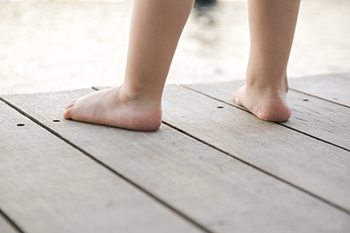 Flat feet, a condition where the arches of the feet touch the ground when you stand, can lead to overpronation. Overpronation occurs when the ankles roll excessively inward with each step during walking or running. This can cause additional strain on the ankles, knees, and hips. Overpronation can also increase the risk of injuries and discomfort due to improper alignment and distribution of body weight. People with flat feet may experience fatigue in their feet and legs, and suffer from pain in the heel or arch area. To help manage symptoms of flat feet and any issues resulting from overpronation, a podiatrist, or foot doctor, may recommend orthotic devices. These are insoles that fit into shoes to provide support for the arches, correct the pronation, and enhance overall foot function. Proper footwear that offers stability and support is also important to effectively manage overpronation. Regular check-ups with a podiatrist can ensure that individuals with flat feet receive the necessary support and guidance to prevent any issues. If you have flat feet, or suspect overpronation when walking, it is suggested you make an appointment with a podiatrist for a full exam and possible gait analysis.
Flat feet, a condition where the arches of the feet touch the ground when you stand, can lead to overpronation. Overpronation occurs when the ankles roll excessively inward with each step during walking or running. This can cause additional strain on the ankles, knees, and hips. Overpronation can also increase the risk of injuries and discomfort due to improper alignment and distribution of body weight. People with flat feet may experience fatigue in their feet and legs, and suffer from pain in the heel or arch area. To help manage symptoms of flat feet and any issues resulting from overpronation, a podiatrist, or foot doctor, may recommend orthotic devices. These are insoles that fit into shoes to provide support for the arches, correct the pronation, and enhance overall foot function. Proper footwear that offers stability and support is also important to effectively manage overpronation. Regular check-ups with a podiatrist can ensure that individuals with flat feet receive the necessary support and guidance to prevent any issues. If you have flat feet, or suspect overpronation when walking, it is suggested you make an appointment with a podiatrist for a full exam and possible gait analysis.
Flatfoot is a condition many people suffer from. If you have flat feet, contact Michael Tomey, DPM from Cary Foot & Ankle Specialists. Our doctor will treat your foot and ankle needs.
What Are Flat Feet?
Flatfoot is a condition in which the arch of the foot is depressed and the sole of the foot is almost completely in contact with the ground. About 20-30% of the population generally has flat feet because their arches never formed during growth.
Conditions & Problems:
Having flat feet makes it difficult to run or walk because of the stress placed on the ankles.
Alignment – The general alignment of your legs can be disrupted, because the ankles move inward which can cause major discomfort.
Knees – If you have complications with your knees, flat feet can be a contributor to arthritis in that area.
Symptoms
- Pain around the heel or arch area
- Trouble standing on the tip toe
- Swelling around the inside of the ankle
- Flat look to one or both feet
- Having your shoes feel uneven when worn
Treatment
If you are experiencing pain and stress on the foot you may weaken the posterior tibial tendon, which runs around the inside of the ankle.
If you have any questions please feel free to contact our office located in Cary, NC . We offer the newest diagnostic and treatment technologies for all your foot and ankle needs.
Flat Feet
Flatfoot is a foot condition in which the arch of the foot has either partially or totally dropped or has never developed. While it is common in babies and small children, it can become a problem for them in adulthood if the arch never forms. For adults, the development of flat feet can be brought upon by injury, as a result of pregnancy due to increased elasticity, or obesity. Those who have health concerns such as rheumatoid arthritis or diabetes may also be at greater risk for developing the condition.
If you suspect that you have flat feet, it is best to consult your podiatrist. Your foot doctor will examine the suspected foot and observe how it looks while you sit and stand. He or she may take an X-ray to determine how serious the condition is. Some common signs of flatfoot include toe drift, in which the toes and front part of the foot point outward, a short Achilles tendon, and a heel that tilts outwardly while the ankle tilts inward.
Once flatfoot has been diagnosed, your podiatrist may suggest one of several treatment options. Flat feet can be rigid, in which the feet appear to have no arch even when the person is not standing; or flexible, in which the person appears to have an arch while not standing, but once standing the arch disappears. Those with flexible flatfoot may be told to reduce any activities that cause pain and to avoid extended periods of walking or standing. Another suggestion may be weight loss, as excessive weight may be placing pressure on the arches
In few cases, if the condition is severe and all other methods have been exhausted surgery may be required. This is normally avoided, however, due to a lengthy recovery time and high cost.
The Hidden Risks of Wearing Flip-Flops
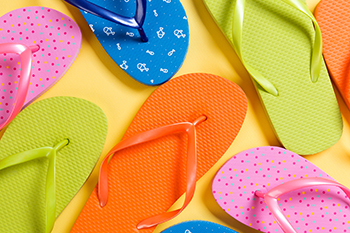
Flip-flops are loved for their convenience and casual style, and may seem like the perfect footwear choice for warm weather. However, wearing flip-flops regularly can pose significant risks to your foot health. One major issue is the lack of support they provide, leading to improper weight distribution and strain on the arches and heels of your feet. This lack of support can contribute to conditions like plantar fasciitis and arch pain. Additionally, the thin sole and minimal straps offer little protection against sharp objects or uneven surfaces, increasing the risk of injuries like cuts, bruises, and sprains. Constantly gripping the toes to keep flip-flops in place can also lead to muscle fatigue and toe deformities over time. Furthermore, flip-flops offer little or no shock absorption, which can lead to impact-related injuries like stress fractures. While they may be tempting for casual outings, it is important to prioritize footwear that offers proper support. If you have developed one of several foot conditions from wearing flip-flops, it is suggested that you consult a podiatrist who offer effectively treatment options.
Flip-flops are not always the best choice of footwear. If you have any concerns about your feet or ankles, contact Michael Tomey, DPM from Cary Foot & Ankle Specialists. Our doctor will assist you with all of your foot and ankle needs.
Flip-Flops and Feet
When the weather starts warming up, people enjoy wearing flip-flops. Flip-flops are comfortable, stylish, and easy to slip on and off; they're perfect for any summer beach goer. However, these shoes can cause harm to the feet.
How Can Flip-Flops Affect Me Long-Term?
- Ankle problems
- Hip problems
- Lower back problems
- Pain in the balls of the feet
- Problems with foot arches
- Changes in the way you walk
Are There Injuries Associated with Flip-Flops?
Yes. Since flip-flops are relatively weak and do not provide the same amount of support as sneakers, people who wear flip-flops regularly are more susceptible to injuries. On top of that, the open nature of the shoe makes your feet more prone to other problems, such as cuts and even infections. Common injuries and ailments include:
- Sprained ankles
- Blisters
- Infections
- Cuts and Scrapes
I like Wearing Flip-Flops. Are There Safe Alternatives?
When buying flip-flops, try to find ones that have sturdy soles and that are made of high-quality materials that will support for your feet. These flip-flops will cost more but will also last longer as a result.
If you have any questions please feel free to contact our office located in Cary, NC . We offer the newest diagnostic and treatment technologies for all your foot and ankle needs.




